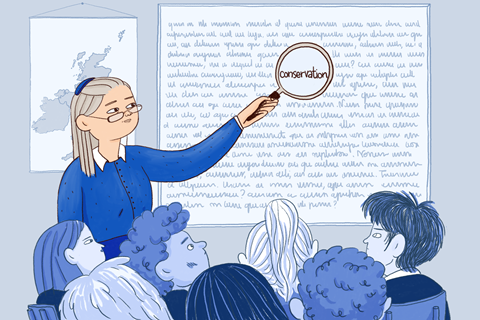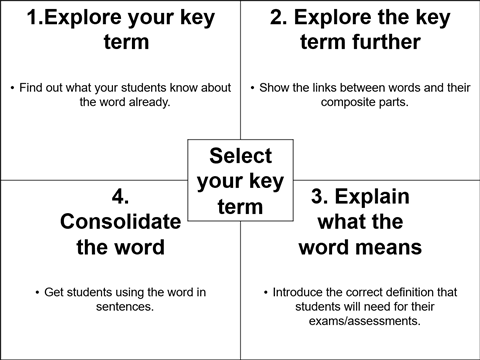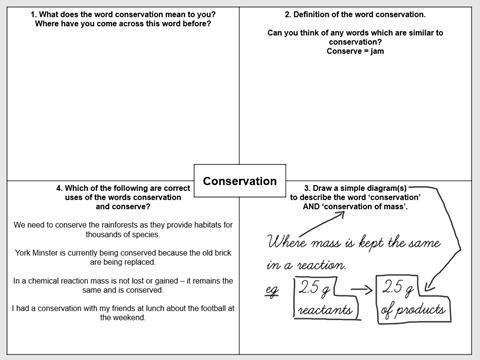Tackling tricky terms

You arrive back to work after the holiday. You have a whole staff briefing outlining the whole school teaching and learning objective – ‘To improve the quality of our teaching so that we develop our students’ communication skills and enhance their knowledge, understanding and use of academic vocabulary.’ Your line manager is a former head of English and you are armed with the EEF’s Improving secondary science guidance. The world is your oyster. Challenge duly accepted. Here’s an overview of how I used the guidance to improve the vocabulary of my students.
As science teachers, we introduce new words to our learners virtually every lesson, tier 3 vocabulary – subject specific vocabulary. I use the EEF’s guidance, specifically 6a and 6b, and the graphic organiser known as the Frayer model to address the science vocabulary gap in my students.
The Frayer model has been used in classrooms for many years (the idea was first developed by Dorothy Frayer and colleagues at the University of Wisconsin). It is a simple but effective model to help students to organise their understanding of a new piece of vocabulary.
I adapted the Frayer model as follows:

Download examples of adapted Frayer models as MS Powerpoint or pdf to use with your students.
How does it all work then?
First, select the key term you want to study – this usually relates to the topic you are teaching. For example, when teaching conservation of mass to year 8, the key term I wanted them to get to grips with was ‘conservation’.
7 simple rules to boost science teaching
Click to expand and explore the rules
Build on the ideas that pupils bring to lessons
Help pupils direct their own learning
Use models to support understanding
Support pupils to retain and retrieve knowledge
- Pay attention to cognitive load—structure tasks to limit the amount of new information pupils need to process
- Revisit knowledge after a gap to help pupils retain it in their long-term memory
- Provide opportunities for pupils to retrieve the knowledge that they have previously learnt
- Encourage pupils to elaborate on what they have learnt
Use practical work purposefully and as part of a learning sequence
Develop scientific vocabulary and support pupils to read and write about science
Use structured feedback to move on pupils’ thinking
Stage 1 – Explore the key term
- This links with the idea of science capital – eliciting what your students already know about a concept in science and valuing their contribution.
- Taking the ‘conservation’ example, many of my students had heard of the word conservation, in terms of ‘conservation of habitats’ and ‘conserving York Minster’ (we are a York school).
Stage 2 – Exploring the key term further
- This links in very nicely with the EEF’s guidance on showing students the composite parts of words. I think it’s really interesting that throughout the guidance report ‘direct instruction’ and ‘enquiry-led teaching approaches’ are discussed, but at no point is there backing of either approach – it’s very dependent on the learning taking place. However, the guidance report does state that teaching composite parts of word should be teacher-led.
- This is probably the most challenging aspect of this teaching approach – my Latin and Greek are both non-existent, but a bit of careful internet searching of your key term followed by etymology should yield some very interesting results – I know I learned an awful lot!
- The guidance report gives a great example of ‘photosynthesis’ and there’s a useful worksheet with Help your students decode science vocabulary.
Stage 3 – Explaining what the word means

- This is again, another teacher-led section.
- Using the previous discussion of the composite parts of the word we define the phrase ‘conservation of mass’.
- We know (from exploring the word in stage 2) that conservation is ‘where something is kept the same’.
- Thus, conservation of mass is ‘where the mass is kept the same’.
More vocabulary resources
- Four steps to break down definitions, clarify tier 3 vocabulary and build your learners’ confidence.
- Help all learners master scientific vocabulary and access content confidently with these strategies.
- Use the Frayer model to ssess learner understanding and science capital.
Stage 4 – Consolidate the meaning of the word
- This is where students have a bit of time to put their newly learned key piece of vocabulary into action. It may be they write a little paragraph using the word/phrase. Or in the example (downloadable below), identify sentences where the word has been used correctly and incorrectly. They could then explain why they have made that decision.
It is all about selecting the words carefully, then exploring them by breaking them up into their composite parts and giving students the opportunity to consolidate their learning of the new vocabulary.
This article is part of the series 7 simple rules for science teaching, developed in response to the EEF’s Improving secondary science guidance. It supports rule 6a, Carefully select the vocabulary to teach and focus on the most tricky words.
Downloads
Example Frayer models
PowerPoint, Size 0.16 mbExample Frayer models
PDF, Size 75.22 kb










No comments yet